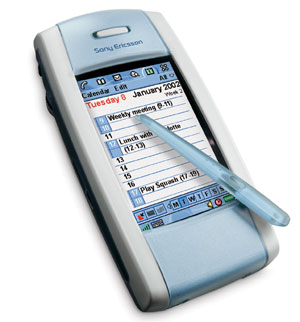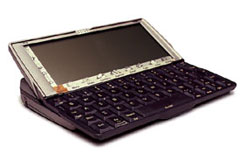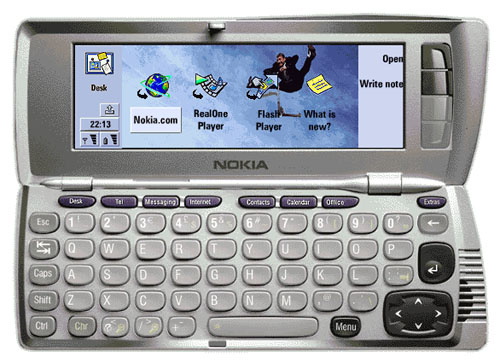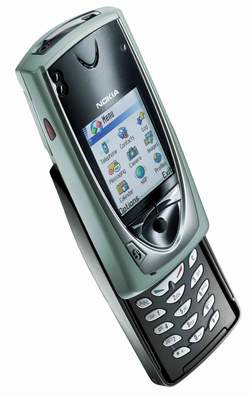Introduction
 |
Smartphones and communicators - those words are already firmly entrenched in our everyday vocabulary. Handheld devices are increasingly part of our lives. Of the expensive toys that are available only a very secured the people, they are gradually becoming an essential attribute of modern humans, and not only a businessman. Mobility - that is the keyword of modern information technology. For a start I would like some clarification of terminology. Under the usual smartphone is commonly understood bezklaviaturnoe device (like a Sony Ericsson P800), primarily designed for data access and designed for a wide range of users, the communicator is commonly called a functional device with keyboard, large screen and oriented generally more " professional "users. Equipped with high-speed data functions such as GPRS or HSCSD, such a device allows a person to constantly be on the "edge" of events, receive email, browse Web pages, work with documents, faxes and so on. Not all agree to wear a bag or briefcase heavy full-sized notebook. Apart from the fact that most of the computing power just idling, the low battery life does not give the opportunity to work, for example, all the time during a long flight or trip. In addition, the low reliability of widespread operating system for desktop machines (especially the notorious family of Windows 9x), their poor suitability for use in mobile devices, excessive requirements to hardware resources (especially memory and disk space), the possibility of mechanical damage to computer components (especially refers to hard drives) make use of these expensive and bulky devices unjustified. High demands of modern mobile devices, particularly in terms of power consumption and reliability of operating systems and programs to fail food that caused the market for new operating systems designed with these requirements. It is for these devices and was created by Symbian OS (formerly EPOC 32).
The story of Symbian OS
Operating System Symbian OS (EPOC 32) was developed by Symbian - a joint venture firms Motorola, Ericsson, Nokia and Psion-based Psion Software division of Psion. Later they were joined by company Matsushita, Kenwood, Fujitsu, Siemens and others. The first release ("Release») EPOC 32 in April 1997 marked the birth of a new generation of operating systems based on extensive experience in the industry the company Psion handheld mobile devices. For thirteen years before, in 1984, the company Psion has invented a personal organizer. With sales of the next model - Organiser II - corporate and private clients with more than one million units. This model had an 8-bit CPU, and could be programmed in assembly language or BASIC-like high level language OPL (Organiser Programming Language). Since 1991, a series of devices under a common brand Psion Series 3 Take a personal digital organizer popular and affordable mass-market device. The new OS is called SIBO (SIxteen-Bit Organiser), often it is also called SYMBIAN OS16. In the system of SIBO was first applied technology is the core allocation and application interfaces into separate components, which subsequently became an integral and important part of the 32-bit SYMBIAN OS. However, since most of the core system was written in assembly language, but also because of the restrictions for 16-bit architecture x86, SIBO system could not be used anywhere except processors x86. Graphical frontend SIBO was an object-oriented, and built-in editor and translator of the language OPL allows them to be directly on your PDA. Platform SIBO A myriad of applications. At the same time for the corporate market has been developed industrial terminal WorkAbout, first introduced in 1995. Total sales of devices has exceeded 1.5 million units.In the period of greatest popularity in the share of Series 3 accounted for 35% of world market organizers. One major reason for this was the convenience and functionality of applications SIBO, reliability and efficiency of multi-tasking operating system (which throughout its existence was virtually no errors found), high quality built-in ROM software, long battery life and stylish design firm.
 |
Over time, handheld computers become more powerful. By 1994, a limit of 64KB, which is characteristic for 16-bit systems have become a serious obstacle to the development of software is also becoming clear that the system of this class should be portable to a wider range of devices. So a new system SYMBIAN OS. Retaining the best features of previous OS Psion, it was to be fully 32-bit portable to any hardware platform and architecture. This would allow SYMBIAN OS to become an open system, available for licensing to third-party manufacturers of mobile devices. To this end, the group Psion has been allocated an independent company to develop software - Psion Software. The new system was to become the standard for wireless information devices by licensing a broad range of manufacturers of this industry. In April 1997 came the first version SYMBIAN OS - Release 1 - and immediately at its base the new product: Psion Series 5. Licensing of the new OS had begun even before its official publication. SYMBIAN OS, with its efficiency and flexibility, as well as high technical standard Symbian (formerly Psion Software) have formed a very good basis for creating a new system software for wireless devices. The company Psion Software was selected from a group of companies Psion Group, and changed its name to Symbian Ltd, becoming a joint venture between Ericsson, Nokia, Motorola and Psion. From the outset the system was designed as a fully object-oriented. As the language has been chosen C + + as the most powerful and most complex to date, object-oriented programming language.
Goal of creating a Symbian OS (SYMBIAN OS 32)
Attractiveness to Users
Mobile devices are intended for personal use. They should be easy to use, and always provide information on demand (the principle of "Instant-On"). System graphical user interface and firmware must be attractive and intuitive. An efficient multi-tasking. Power management should allow the computer when you switch instantly restore the state in which he was at the time off without the long process of booting the system. When replacing the power source (batteries) data should be preserved. Software in ROM should be of the highest quality. These lessons the company learned Psion back in time Organiser II, when the majority of desktop PCs were running DOS, a "portable" computer was the size of a diplomat. Suite of applications - a critical factor for creating attractive from the standpoint of the end user. SYMBIAN OS applications are designed with the expectation and the beginner and professional. About ten major applications and the entire operating system had to fit in a ROM, which amounts to about 1 / 10 of the average application for the PC. Such a compact has been achieved by the highest degree of reusability, the use of object-oriented design, C + + language and the tight junction development teams dealing with various aspects of the OS and applications. Digital communications are widely used in today's world. SIBO architecture was designed for organizers who are independent units, which only rarely had to communicate with other devices for data backup. Devices based on SIBO well have existed without connection to a PC.Currently, communications using the Internet, fax and mobile phones has become commonplace, and synchronized with the data on the desktop, at home and at work, has become extremely important for mobile devices. Mechanisms of synchronization and data sharing were originally built into the Symbian OS.
Attractive for OEM-manufacturers
OS Series devices Organiser and SIBO was used only in products of companies of the group Psion. Symbian OS was designed from the outset in order to license a wide range of telecom equipment manufacturers. The main requirement was portability for different types of processors. This, in turn, required the use of high-level language, which could simply be transferred to another platform. Assembly language is used only for implementation of components, which is especially important for speed of execution. In Symbian OS is also widely used abstraction from a particular type of equipment that make it easier to adapt for different variants of a single processor architecture. Despite the fact that SYMBIAN OS is a portable system as the main platform was chosen by Symbian architecture ARM. ARM architecture is exceptionally efficient RISC-strutura providing optimal ratio of performance / power consumption - which is especially important for devices that must operate for weeks on one set of batteries. In addition, through effective use of chip area and correct the company's policy ARM Ltd in respect of licensing ARM architecture provides the best ratio performance / price. ARM architecture licensed these "whales" as Intel, Nokia, etc. Mobile devices are no standards for screen size, keyboard shortcuts, or digitizer. Producers receive complete freedom to create any types of devices, any price range, size and weight. Symbian company made a strategic decision to make a clear separation between the graphical user interface (GUI) and other components. For devices that require non-standard means of user interaction, graphical interface system and applications can be modified or completely redesigned. For example, it will easily adapt to any size and screen resolution, absence / presence of a touch screen, etc. Compared with other platforms it will allow manufacturers of devices based on SYMBIAN OS to create devices with "branded" look and feel of hardware. SYMBIAN OS is an international operating system. Platform SIBO was localized for the UK and the U.S., almost all the languages of Western Europe, and parts of Eastern European languages: Czech, Hungarian, Greek and Russian. IN SYMBIAN OS built-in support for 16-bit encoding UNICODE and special means of data entry to adapt to the languages of Asia and the Far East, such as Japanese, Chinese, Korean and Thai.
Attractive to developers
In order to develop efficient applications using a wide range of advanced development tools. The main requirement was a 32-bit OS, since the writing of applications for SIBO (as for DOS / Windows 3.1) required a significant effort to overcome the limitations in the 64K at the size of the segment caused by using 16-bit architecture to x86. SYMBIAN OS is fully 32-bit, there is no support for older 16-bit programming interfaces (API) is missing. Symbian provides a wide range of development tools for SYMBIAN OS. Program in standard C + + language are created on a PC using an interactive development environment Microsoft Visual Studio and emulator. Then the source code is recompiled and transferred to a PC based on ARM processor with the compiler GNU C + +. It is also possible to develop applications in OPL (similar to the BASIC language), whose roots go back in the days Organiser II. There is also the possibility of writing Java programs using any of the existing development tools for the language Java. On creation of development tools for Symbian OS announced by companies such as Metrowerks (known for its tools CodeWarrior), AppForge (presented the means to develop software for Symbian OS language Visual Basic) and Borland, traditionally strong in the field of visual development tools.
 |
Development History SYMBIAN OS
| Version | Release date | Features | Where Used |
| Release 1 | April 1997 | First edition. The new OS with a set of office applications. | Psion Series 5 1.00 ROM |
| Release 2 | July 1997 | Released a package for PC EPOC Connect, fixes some bugs, added the application EasyFax | Psion Series 5 1.01 ROM, PsiWin 2.0 |
| Release 3 | November 1997 | Email applications are included and the Web, support for remote access and TCP / IP | Geofox One, PCC Synergy
|
| Release 4 | Mid-1998 | Internal release - in the production of virtually no longer available. Pre-release of the Java-machine, Support Email with attached files, EPOC Connect CopyAnywhere (data exchange via Clipboard), other improvements | Message Suite 1.5, PsiWin 2.2
Oregon Scientific Osaris |
| Release 5/5u | June 1999 | A new significantly improved version of the EPOC 32, support for Java, support for color display, improved communications with other devices, optimization, etc. | Psion Series 5mx, Ericsson R380 Smartphone (5u), Ericsson Mobile Companion MC-218, Psion Series 7, Psion NetBook, Psion Revo / Revo +
|
| Release 6 | 2000 | Radically new version incompatible with previous versions. Diversification into standard types (reference design) devices (Crystal, Quartz (later renamed MediaPhone) and Pearl). Full support for Unicode, Bluetooth, working arrangements with different encodings in the mail and the Web, advanced multimedia capabilities. | Nokia 9210/9210i/9290 |
| Release 6.1 | 2001 | Support for GPRS (so-called Packet Release) | No data |
Release 7
| 2002
| The new interface for UIQ devices bezklaviaturnyh
| Sony Ericsson P800 |
SYMBIAN OS today
What is a Symbian OS today? This full-featured operating system designed to offer all the telecommunications industry and the most modern standards and protocols such as Bluetooth, GPRS, etc. Core of the system - multitasking, high-performance and extremely compact - can be inexpensively transferred to almost any platform. Full Unicode support allows you to easily adapt the system for any language, flexible extension mechanisms enable us to solve all the problems with encoding-mail, Web, etc.
 |
Starting with version 6.0, introduced diversification to "family" of devices (reference design).At the moment, defined 3 classes of devices: bezklaviaturnye PDA with a form factor reminiscent of Palm and Pocket PC (example - Sony Ericsson P800) - MediaPhone (formerly Quartz), keyboard communicators Crystal (Nokia 9200 Series) and smartphones Pearl (Nokia 7650). All three families share the same core, the differences mostly limited to the user interface, form factor, the absence / presence of a touch screen, etc. Here, Symbian OS, unlike, for example, Windows CE, gives manufacturers complete freedom of action - and this is evident if we compare, for example, Nokia 9210 and Nokia 7650. Symbian OS supports the majority of the standards adopted in the industry of mobile communications: GSM / EGSM, GPRS, HSCSD, CDMA.
Set of applications (Application Suite)
The composition SYMBIAN OS includes a full suite of office productivity, organizational and communication applications. To control the computer and applications used by a graphical shell. All applications share the following features:
- careful study of the user interface to make applications really easy to use, regardless of the level of preparation by the user
- standard graphical controls that are implemented in the library EIKON, including a toolbar (toolbar), tool bar (toolband), convenient control with a keyboard and / or pen
- Zoom the image on the screen to adjust the image according to the type of application data, lighting conditions and user's perspective
- support for printing on most standard printers, printing via serial, parallel or infrared port or a printer connected to a desktop PC
- support for embedded objects, allowing, for example, to embed Word documents in the record Agenda
- exchange of data between applications through a standard clipboard (clipboard), communicate with other devices via infrared
SYMBIAN OS designed for the purpose of licensing a wide range of manufacturers for various devices. Producers may need to change the look of applications and systems, and the need to maintain compatibility with existing products. Standard shell EIKON was designed for devices with pen input, keyboard and monochrome screen with a resolution of 640x240 pixels, for the devices, the specifications of which differ significantly from those listed above, you may need a graphical interface that looks and even, perhaps, the realization of which is significantly different from EIKON. SYMBIAN OS was designed in such a way as to allow the replacement of a standard shell EIKON any other graphical user interface. In this case, most likely also need modification and applications. Most applications have some sort of "core", the main purpose of which - data processing of this application, ensure their integrity. For example, the nucleus of a word processor works with the text of the document, while ensuring the conservation and proper updating of the text formatting, storage, embedded objects, etc. Kernel code should be reliable, and provide all the necessary application functionality. When implementing complex operations such as sorting and searching, the kernel must provide an acceptable speed. Along with the kernel, the application must also contain the UI code, which is usually used to exchange data and commands between the GUI and the kernel and display the results. Applications SYMBIAN OS formalize the distinction between the core and the graphical user interface (GUI). Although the creation of a "monolithic" applications are still possible, for example for training purposes, all of the major applications are in the form of a dynamic library containing the core of the application, completely independent from the GUI EIKON, and the library that implements the application interface. If your application is processed for a system in which there is no shell EIKON, the advantages of this approach are obvious:
- All changes can be reduced solely to the processing interface
- kernel does not require any changes, recompile and test, which is especially important because, for example, the nucleus of a word processor - an extremely complex system
Separation of the core and the graphical user interface creates advantages for any application, in addition, an application can have several different representations of data.Previously been given the arguments in favor of such a separation - when you change the system's interface, only a small part of the application would require modification and re-testing. Such a division is also very beneficial in terms of software development. Different teams of developers can work on creating the core and interface. The objectives of these teams will also be different: while for kernel developers main goal is reliability and efficiency of algorithms, the developers of the same interface can concentrate their efforts on ease of use and appearance. The team that develops the core, can be used in testing is much more sophisticated tests than those necessary for testing graphical user interface - whether it interacts directly with the user or the use of any automated way to generate test inputs, such as using scripts. As a result, developed a way software is a product of the highest quality. This approach is used by Symbian as a standard for software development. When considering the programming languages and data synchronization mechanisms we will see other benefits of separating the core and interface.
Data exchange and synchronization
SYMBIAN OS was designed for effective self-study. Good keyboard handheld computers, such as Nokia 9210, and well-designed application allows to work with large volumes of data. Small size of computers based on SYMBIAN OS enables users to always carry them with you and enter any information as necessary. However, there are still several reasons for the integration of handheld computers based on SYMBIAN OS with a desktop PC - from backup, document conversion formats of PC applications in formats SYMBIAN OS and vice versa, to complete synchronization desktop PC and PDA based on SYMBIAN OS at home and at work. These requirements were taken into account when creating a product SYMBIAN OS Connect (formerly EPOC Connect / PsiWin). Product SYMBIAN OS Connect runs on PCs running Microsoft Windows 95/98/2000/XP/ME or Microsoft Windows NT 4.0 and provides
- integration with Windows Explorer and the Windows desktop for easy data management of computers based on SYMBIAN OS or SIBO, the connected PC
- file sharing, backup and data recovery
- work with several SYMBIAN OS-computers with a desktop PC
- convert files from formats OS SYMBIAN OS in the desktop application formats (such as the formats of popular office applications from Microsoft, Lotus, Corel and other software proizvodieteley) and back
- synchronization at the field level between SYMBIAN Agenda and SYMBIAN Contacts and related desktop applications
- Printing from SYMBIAN OS applications to any printer connected to the PC
- installation of software from your PC to SYMBIAN OS-PC
Manufacturers, licensed SYMBIAN OS, can give products based on SYMBIAN OS Connect different names (eg, bundled with the Nokia 9210 comes a product called PC Suite for Nokia 9210 Communicator).
Comparison with other operating systems
Symbian OS is not the only system on the market. In addition to the large number of "brand» (proprietary) operating systems that we will not consider because of the small distribution of Symbian OS are the 2 main competitors:
- Microsoft Windows CE - in fact it is "reduced" version of the desktop operating system with all its consequences - "voracity", unstable work on devices with significantly reduced hardware resources (with interest to hear about friends who use Pocket PC, how many times a day they make a "hard reset") - in short, everything that is familiar to any user of products Microsoft. The growing needs of the system, as well as on desktop computers, offset by increases in processing power, memory, etc. Modest for hardware features Nokia 9210 is easy to cope with the tasks on which Windows CE in a similar configuration would be simply "died". However, knowing the marketing opportunities of Microsoft, there is no doubt that the battle for the smartphone market will be a life and death.The latest versions - Windows CE for Smartphone - have features of the phone, which, however, is far from capacity Symbian OS.
- PalmOS - the operating system has been successfully used by Palm and its licensees (Sony, Handspring, Samsung) on mobile devices. At the moment, PalmOS is a leader in number of units sold, but rapidly losing ground. This system is designed to perform the functions of the organizer (with which it handles brilliantly), so it lacks important features such as multitasking, efficient memory management, etc. And although the Palm OS is constantly evolving to address those problems for which it claims, is necessary to develop radically new operating system.
You can also mention Linux - to the OS are often interested in some of the developers of handheld devices (eg, Sharp Zaurus has released an interesting device based on Linux), but in my opinion, it is not justified - the same story with the transfer of a desktop OS in a "pocket" size . The authors, translation:
Vladislav Voronin



